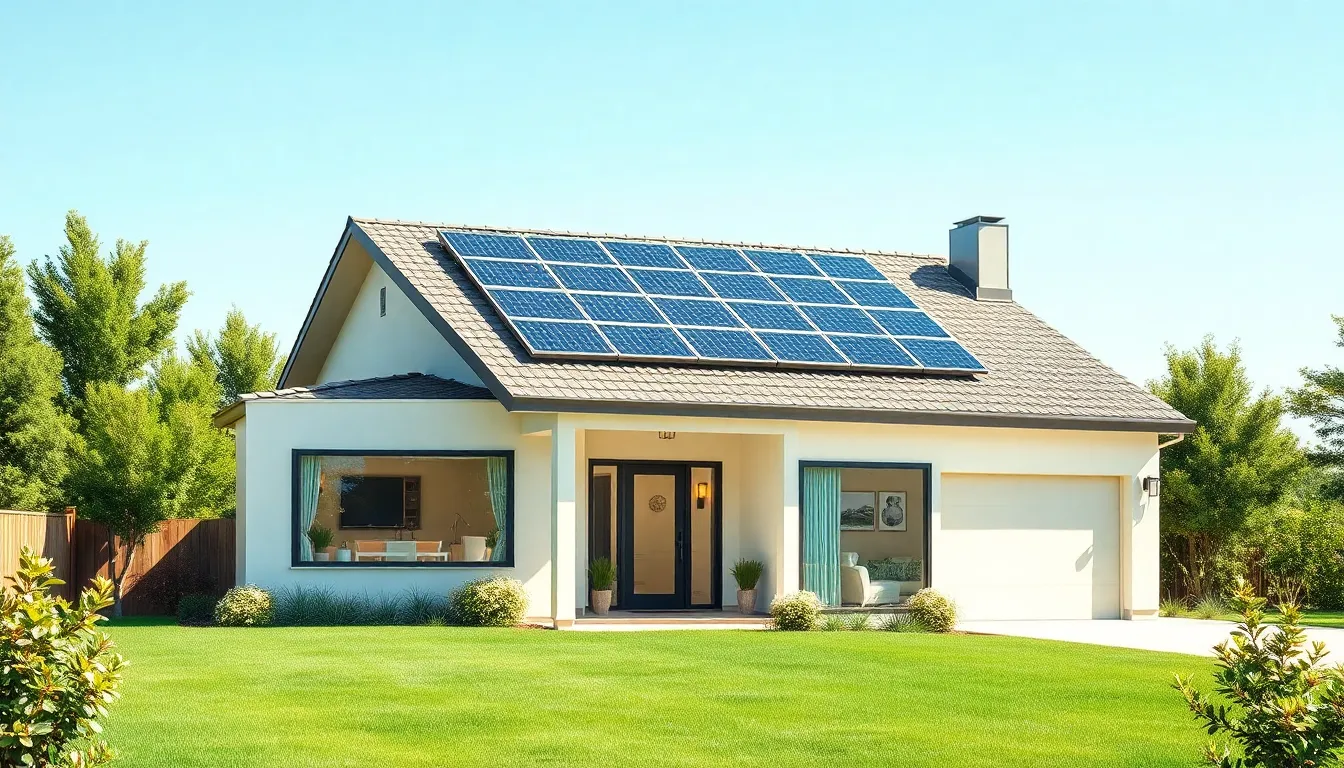Table of Contents
ToggleIn the land of sunshine and endless summer, California is taking a giant leap into the future with energy smart homes. Imagine a home that not only knows when to dim the lights but also serves up a refreshing breeze while keeping your energy bills as low as your favorite beach’s tide. Sounds like a dream, right? Well, it’s time to wake up and smell the solar panels!
These innovative homes are not just about saving the planet; they’re about making life easier and a whole lot cooler. With cutting-edge technology, homeowners can control everything from heating to lighting with just a tap on their smartphones. So, if you’re ready to turn your house into a smart sanctuary that’s as eco-friendly as a reusable shopping bag, dive into the world of California’s energy smart homes. Who knew being green could feel so good?
California Energy Smart Homes Overview
California’s energy smart homes incorporate advanced technology designed for maximum efficiency and sustainability. These homes adapt to the needs of their residents while significantly lowering energy consumption.
Definition of Smart Homes
Smart homes feature interconnected devices and systems that enhance home management. They include smart appliances, heating, lighting, and security systems that homeowners control remotely via applications on smartphones or tablets. These homes utilize sensors, automation, and artificial intelligence to optimize energy use, providing convenience and improving living conditions. The seamless integration of these technologies ensures home environments are responsive to occupants’ needs and preferences.
Importance of Energy Efficiency
Energy efficiency plays a crucial role in reducing utility costs and environmental impact. Smart homes in California prioritize this efficiency, leading to lower energy usage and decreased greenhouse gas emissions. Enhanced insulation, energy-efficient appliances, and renewable energy sources, such as solar panels, contribute to a home’s sustainability. By investing in energy smart homes, residents enjoy not only immediate financial savings but also long-term benefits, including increased property value and a reduced carbon footprint.
Key Features of California Energy Smart Homes

California energy smart homes boast innovative features that enhance efficiency and sustainability. Homeowners leverage advanced technologies to create a more comfortable living environment while minimizing energy costs.
Renewable Energy Sources
Renewable energy sources play a critical role in California energy smart homes. Solar panels provide clean, renewable electricity, significantly reducing reliance on fossil fuels. Wind turbines, although less common in residential settings, also contribute. Communities often share resources through solar farms, boosting regional sustainability. Tax incentives encourage homeowners to install these systems, enhancing overall investment value. By utilizing solar power, residents enjoy lower utility bills and a reduced carbon footprint.
Smart Technology and Automation
Smart technology and automation transform daily living in energy smart homes. Homeowners control appliances, lighting, and heating systems remotely via smartphone apps. Programmable thermostats adjust temperatures based on user preferences and schedules, optimizing energy use. Smart lighting systems use sensors to detect occupancy, minimizing waste during unoccupied hours. These interconnected devices enhance convenience while promoting energy efficiency. Real-time data monitoring allows residents to track their energy consumption patterns, encouraging conscious usage.
Energy Management Systems
Energy management systems (EMS) integrate various technologies to optimize energy consumption in smart homes. These systems analyze real-time data to identify usage trends and provide tailored recommendations. Homeowners access detailed reports on their energy habits, making informed decisions to reduce costs. Automated demand response functionality enables homes to adjust energy usage during peak periods, decreasing strain on the grid. Overall, EMS improves operational efficiency while supporting environmental sustainability efforts.
Benefits of California Energy Smart Homes
California energy smart homes offer numerous advantages that enhance homeowner experiences and promote sustainability in the state.
Cost Savings on Energy Bills
Energy smart homes provide significant cost savings on energy bills through innovative technologies. Smart appliances and energy-efficient systems optimize energy use, reducing waste and lowering utility expenses. Homeowners can monitor real-time data to identify peak usage times and adjust their consumption accordingly. For instance, programmable thermostats minimize heating and cooling costs by allowing homeowners to set schedules that align with their routine. Utilizing renewable energy sources, such as solar panels, further decreases dependence on the grid, leading to substantial reductions in monthly energy expenses.
Environmental Impact
California energy smart homes contribute positively to the environment by minimizing carbon footprints. By employing renewable energy sources, they reduce reliance on fossil fuels, ultimately decreasing greenhouse gas emissions. Energy-efficient appliances and enhanced insulation help lower overall energy consumption, supporting statewide efforts to combat climate change. Smart home technologies also encourage sustainable practices, enabling homeowners to track their energy usage and implement eco-friendly habits. Collectively, these initiatives create a more sustainable living environment that benefits both residents and the planet.
Increased Property Value
Integrating energy smart technologies increases property value in the competitive California real estate market. Homes equipped with renewable energy systems and smart technologies attract environmentally conscious buyers, willing to pay a premium for energy-efficient features. Studies indicate that energy-efficient homes sell for 2-5% more than traditional homes, reflecting rising demand. Furthermore, tax incentives for energy investments not only enhance financial viability but also appeal to future homeowners looking for long-term savings. Consequently, energy smart homes position owners for higher returns on investment when selling or refinancing.
Challenges in Implementing Smart Homes
Implementing smart homes in California presents various challenges that can hinder adoption. Understanding these obstacles is crucial for potential homeowners and developers.
Initial Investment Costs
Initial investment costs pose a significant barrier to adopting energy smart homes. These homes often require substantial upfront expenditures for advanced technology, smart appliances, and renewable energy systems. For instance, installing a solar panel system can cost between $15,000 and $30,000, depending on the size and complexity. While incentives exist, such as federal tax credits and state rebates, upfront costs remain a notable concern for many homeowners. Budgeting for such investments requires careful planning, which can deter interest in smart home features.
Technological Limitations
Technological limitations often restrict the full potential of smart homes. Many older homes lack infrastructure compatible with modern technology, necessitating additional upgrades. For example, existing wiring and HVAC systems may require significant modification or replacement to support smart technology. Furthermore, compatibility issues arise when integrating various smart devices from different manufacturers. Common problems include connectivity drops and inconsistent performance, which can frustrate users and reduce trust in smart home solutions.
Regulatory Hurdles
Regulatory hurdles impact the widespread implementation of energy smart homes. Local building codes and zoning regulations can impede the installation of energy-efficient technologies. California’s regulations vary widely by jurisdiction, leading to inconsistency in permitting processes. Homeowners may encounter challenges in obtaining approvals for solar installations or energy-efficient system upgrades, lengthening timelines and increasing costs. Navigating these regulatory landscapes can deter homeowners from pursuing energy smart home investments.
California’s energy smart homes represent a significant shift toward sustainable living. By leveraging advanced technologies and renewable energy sources, these homes not only lower utility costs but also enhance the overall quality of life for residents. The benefits extend beyond individual homeowners, contributing to broader environmental goals and reducing carbon footprints.
While challenges like initial investment costs and regulatory hurdles exist, the long-term advantages make energy smart homes an attractive option. As technology continues to evolve and become more accessible, California’s commitment to energy efficiency and sustainability will likely pave the way for a greener future. Embracing this trend could lead to a more resilient and eco-friendly community for all.









